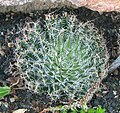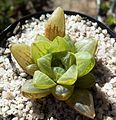|
Haworthia
Haworthia is a large genus of small succulent plants endemic to Southern Africa (Mozambique, Namibia, Lesotho, Eswatini and South Africa).[1] Like aloes and gasteria they are members of the subfamily Asphodeloideae and they generally resemble miniature aloes, except in their flowers, which are distinctive in appearance. They are popular garden and container plants. These plants were discovered by Henri Auguste Duval (1777-1814) in 1809. The genus name is derived from Adrian Hardy Haworth’s (1767-1833) name, a botanist and avid succulent collector. Description and characteristicsHaworthias are small succulent plants, forming rosettes of leaves from 3 cm (1.2 in) to exceptionally 30 cm (12 in) in diameter, depending on the species. These rosettes are usually stemless but in some species stems reach up to 50 cm (20 in). The inflorescences of some species may exceed 40 cm (16 in) in height. The plants can grow solitary or can be clump-forming. Many species have firm, tough, fleshy leaves, usually dark green in colour, whereas others are softer and contain leaf windows with translucent panels through which sunlight can reach internal photosynthetic tissues. Their flowers are small, and generally white. Though they are very similar between species, flowers from the species in section Hexangulares generally have green striations and those from other species often have brown lines in the flowers. However, their leaves show wide variations even within one species. Additionally, when the plants are stressed (e.g. deprived of water), their colours can change to reds and purples. Depriving them of nitrogen generally results in paler leaves.[2] DistributionMost species are endemic to South Africa, with the greatest species diversity occurring in the south-western Cape. Some species do however extend into neighbouring territories, in Eswatini (formerly Swaziland), southern Namibia and southern Mozambique (Maputaland).[citation needed] Naming and taxonomyHaworthia is a genus within the family Asphodelaceae, subfamily Asphodeloideae. The genus is named after the botanist Adrian Hardy Haworth. B. Bayer recognised approximately 60 species in a review of the genus in 2012, whereas other taxonomists are less conservative. Related genera are Aloe, Gasteria and Astroloba and intergeneric hybrids are known.[3][4] SubdivisionsThe classification of the flowering plant subfamily Asphodeloideae is weak, and concepts of the genera are not well substantiated. Haworthia has been a similarly a weakly contrived genus. Because of their horticultural interest, its taxonomy has been dominated by amateur collectors, and the literature is rife with misunderstanding of what the taxa actually are or should be. Recent[when?] phylogenetic studies have demonstrated that the traditional divisions of the genus are actually relatively unrelated (Hexangulares was shown to be a sister-group of genus Gasteria, Robustipedunculares more closely related to genus Astroloba, and Haworthia as an out-group related to Aloe).[citation needed] In recognition of the polyphyletic nature of the genus, Haworthiopsis and Tulista have ben split off. Botanists had long noticed differences in the flowers of the three subgenera, but had previously considered those differences to be inconsequential, although the differences between species in the same subgenus definitely are. The roots, leaves and rosettes do demonstrate some generic differences while wide variations occur even within one species.[5][6] SpeciesMany species of Haworthia have been moved to Haworthiopsis and Tulista, in particular since the 2013 update of The Plant List, which contains about 150 accepted species of Haworthia. The actual number and identification of the species is not well established; many species are listed as "unresolved" for lack of sufficient information, and the full list reflects the difficulties of Haworthia taxonomy, including many varieties and synonyms.[7] The World Checklist of Selected Plant Families has been updated to exclude the species now in Haworthiopsis and Tulista. The species it accepts as of February 2018[update] are listed below,[8] excluding Haworthia kingiana and Haworthia minor, placed in Tulista by other sources.[9]
 CultivationThere is widespread special collector interest, and some species such as Haworthia cymbiformis are fairly common house and garden plants. Almost all Haworthia species are naturally adapted for semi-shade conditions (in habitat they tend to grow under bushes or rock overhangs) and they are therefore healthiest in shade or semi-shade. However, some species like Haworthia pumila and Haworthia truncata can be adapted to tolerate full-sun. All Haworthia species favour extremely well-drained soil (in habitat they tend to grow in poor sands, in rocky areas). Watering depends on the species (winter or summer rainfall) but most of the common species are tolerant of a variety of watering routines. Over-watering can cause the roots to rot.[10] Rarer species may have more specific requirements.[11] All haworthias are sensitive to frost, and they are rated as winter hardy to USDA zone 10.[12] Haworthia species reproduce both through seed and through budding, or offsets. Certain species or clones may be more successful or rapid in offset production, and these pups are easily removed to yield new plants once a substantial root system has developed on the offshoot. Less reliably, the plants may also be propagated through leaf cuttings, and in some instances, through tissue culture. Gallery for identification
References
External linksWikimedia Commons has media related to Haworthia. |
||||||||||||||||||||||||||||||






































